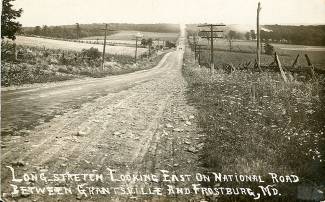Collection Name
About
Garrett County History
"The Underground Railroad"
Text by John A. Grant
The "Underground Railroad" Name:
Escape routes for the Underground Railroad were not restricted to the North, but also to western territories, and to Mexico and the Caribbean.
In 1821, the popularity of the railroad train coupled with legendary flights of certain runaways introduced the name, "Underground Railroad." Supposedly, the term originated when an enslaved runaway, Tice Davids, fled from Kentucky and may have taken refuge with John Rankin, a white abolitionist in Ripley, Ohio.
Determined to retrieve his property, the owner chased Davids to the Ohio River, but Davids suddenly disappeared without a trace, leaving his owner bewildered and wondering if the slave had "gone off on some underground road." The success of Davids' escape soon spread among the enslaved on the southern plantations.
The Underground Railroad consisted of as many varied routes as there were people sympathetic to the plight of the slaves. It is thought that two underground lines entered southwestern Pennsylvania. One crossed the Mason-Dixon Line in southern Green County coming from Morgantown, where it branched with one fork going to Uniontown.
The other route that entered Pennsylvania came from Cumberland Md, via the National Road where slaves would be passed to Somerfield, Pa., and on to Uniontown, Pa.
On The National Road:
In his (1894) book The Old Pike, Thomas B. Searight mentions slaves in the following manner on page 109.
"... for be it remembered that Negro slaves were frequently seen on the National Road. The writer has seen them driven over the Road arranged in couples and fastened to a long, thick rope or cable, like horses. This may seem incredible to a majority of persons now living along the Road, but it is true, and was a very common sight in the early history of the Road and evoked no expression of surprise, or words of censure. Such was the temper of the times."
"...There were Negro wagoners (wagon drivers) on the road, but Negro stage drivers were unknown."
This last sentence about "Negro wagoners" has prompted several writers to speculate about runaway slaves on the National Road. The big freight wagons driven by a Negro driver were large enough to contain a hidden compartment in them where several runaway slaves could hide and be transported over the Mason - Dixon Line into Pennsylvania.
"Stations" In Garrett County:
Undoubtedly, there were safe houses or "stations" along the old National Road in Garrett County where runaway slaves could receive aid in their progress to freedom; unfortunately, no record of them exists. However, it is interesting to note that "stations" were clearly marked as a house that had a candle burning in one window, day and night, or a quilt hanging on a line in the back yard, so they may have existed along the National Road.
Maintaining a "station" was risky business in those days. In addition to supplying food and a hiding place for a runaway slave, operators of a "station" were subject to heavy fines and possible imprisonment under the Fugitive Slave Law of 1850.
However, in the 1978 Garrett County - A History of Maryland's Tableland by Stephen Schlosnagle, on page 216, he records one item about a "station" in Garrett County.
"Stephen Willis Friend of Sang Run operated a station of the Underground Railroad for slaves escaping from the South prior to the Civil War. Among others whom he helped attain freedom was Nancy, a slave belonging to his neighbor, William Hoye."
"By 1850, an estimated twenty thousand blacks had escaped to the North by way of the secret, illegal railroad."
Text: The above article was written by and provided courtesy of John A. Grant for a Garrett County History course offered at Garrett College during 2001 and 2002.
Photograph: Early 1900s postcard view of the National Road in Garrett County taken by Leo J. Beachy, Mt. Nebo Studios, Grantsville, Maryland and from the collection of Albert and Angela Feldstein
Garrett County was officially established as the State's far westernmost county by the Maryland State Legislature in 1872. It was until that time still part of Allegany County. In 1880, the first Garrett County census showed a population of 12,175 people.
